| Summer Holly is a southern Californian and Mexican native shrub or small tree. Despite its common name it is not a member of the Holly Family (AQUIFOLIACEÆ). Instead it is a member of the Heath Family (ERICACEÆ) and is related closely to, and sometimes placed in the large genus Arctostaphylos. The botanist Charles Christopher Parry (1823-1890) discovered Summer Holly in 1878 in San Diego county. He named it first Arctostaphylos arguta var. diversifolia, then Arctostaphylos diversifolia. But Edward Lee Greene transfered it to the genus Comarostaphylis in 1887. |
| Since then, botanists have varied in whether they split Zuccarini's 1837 genus Comarostaphylis from Arctostaphylos or lump the two together. The name Comarostaphylis is from Greek komaros (the Arbutus tree), and staphule (a grape), referring to the clusters of fruit. The name Arctostaphylos is from Greek arktos (a bear), and staphule (a grape), referring to bears liking the fruit. |
| Comarostaphylis is a genus of some 10 to 25 species ranging from Panama to Santa Barbara County; most are Mexican. The species are little known in horticulture. Only Summer Holly is relatively well known, at all cold hardy and cultivated. It was being grown in England by 1896. In the U.S. it is barely ever seen in gardens outside of California. That is why I am writing about it; it is undeservedly rare. I first learned of it at the University of California at Berkeley, in 1991, where 3 grow against the east wall of Mulford Hall, making a winsome display of beautiful red berries against the evergreen foliage background. The tallest is 24 feet. The plants reminded me of the Mediterranean Strawberry Tree (Arbutus Unedo) yet with comparatively tiny and profuse berries. |
In Seattle the Washington Park Arboretum obtained a Summer Holly in 1983 from Colvos Creek Nursery; but it died; in 1990 one was obtained from Heronswood Nursery. It died to the ground in 1997 but grew back and now it is about 8 feet tall, in the rockery where Arboretum Drive East intersects Lake Washington Boulevard. At the Ballard locks in Seattle, on a west-facing building wall (bed number 319), is 16 feet tall thriving tree (photograph below).
|
| Summer Holly can be a shrub or a small tree up to some 30 feet tall. It can be cold-hardy to perhaps 10 degrees Fahrenheit, but since it grows from near sea-level to nearly 2,500 feet, seeds collected from higher elevations will likely give rise to hardier individuals. |
| It is in decline in California, due to development. Unlike most chaparral species, it is more able to tolerate some shade and irrigation or summer moisture, so has a better chance of being cultivated successfully than most species of Arctostaphylos (manzanita). Even if fire or frost cuts it to the ground, Summer Holly resprouts readily from its lignotuber. |
| The plant has value at least in mild, dry summer areas. It can be a shrub, suitable for making a narrow screen. It can be pruned into tree shape. It needs no watering. Its evergreen leaves are attractive, and the shreddy reddish-gray bark adds interest. In spring it makes little white lily-of-the-valley flowers that give rise to its distinctive fruits: narrow clusters of bright red, semi-translucent berries of rough texture (like madrona berries, unlike manzanita berries), each about a quarter of an inch. Isolated specimens can bear fruit; but no doubt cross-fertilization will increase yields. |
The leaves are thick, evergreen, 1.3-5 (6) inches long, and usually edged with fine sharp teeth. The top is rich green and glossy; the underside is usually gray or whitish with felty hairs. The leaf margins tend to be rolled under. But subspecies planifolia has flat leaves; its flower clusters are longer, 2 3/8 - 5 1/2 inches long compared to 1 1/3 - 3 1/6 inches; and it grows farther north in California. The Seattle specimens are of this subspecies.
|
Summer Holly is sold by various California nurseries. Colvos Creek nursery of Vashon Island, Washington, has sold it since the late 1970s.
Back |
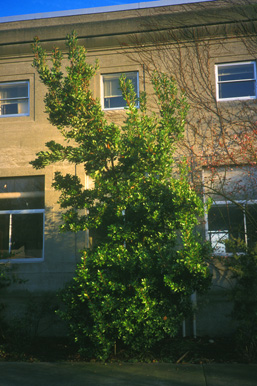
Comarostaphylis diversifolia photo by ALJ
|
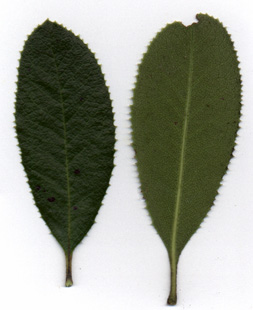
Comarostaphylis diversifolia leaf scan by ALJ
|
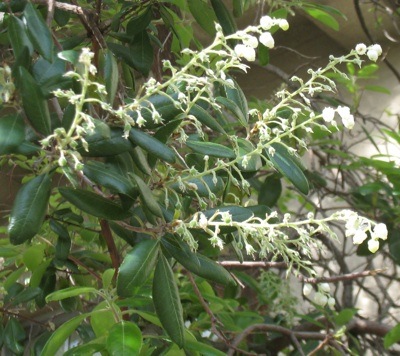
Comarostaphylis diversifolia flower photo by ALJ
|
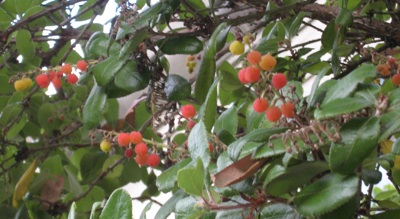
Comarostaphylis diversifolia berries photo by ALJ
|
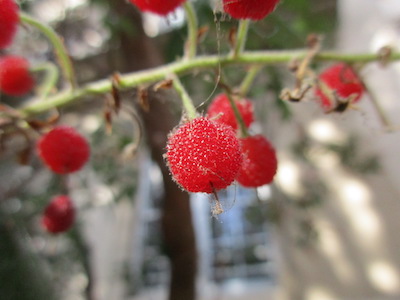
Comarostaphylis diversifolia berries photo by ALJ
|
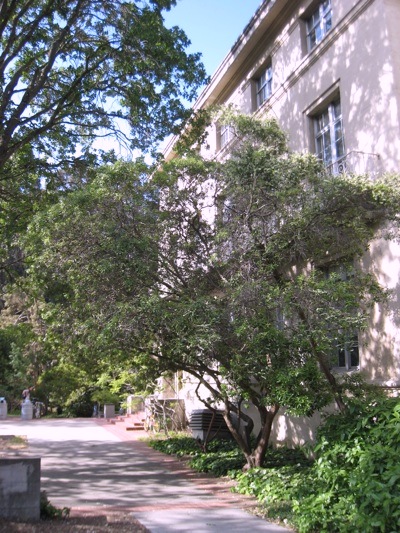
Comarostaphylis diversifolia at Berkeley photo by ALJ
|

